PlayStation Home: Stale or Dynamic?
by NorseGamer, HSM Editor-in-Chief
Raise your hand if you’ve experienced the frustration of biting into a stale piece of food.
It’s maddening, isn’t it? Just when you really want it, just when you’re ready to tear into it like Marcelo Mastroianni finally taking Sophia Loren into his embrace, you sink your teeth in and meet such a wrong combination of texture and blandness that for a moment all you can do is make sounds vaguely akin to black bear afflicted with Tourette’s.
As I write this, it’s NFL Sunday. I have a tradition: every NFL Sunday, I sit down in front of the TV with chips and hot salsa, and I devote the day to gaining weight. This morning, I pulled the salsa out of the fridge, unclipped my bag of Tostitos Scoops, served myself the perfect salsa-to-chip ratio, bit down – and went off on a muffled Yosemite Sam blue streak.
God, I hate stale food. Stoopid corn chips. Be more fresh!
Fortunately, I had an unopened backup bag of chips. I always have more chips and salsa. Which I’m eating right now. Because we don’t screw around in the Norsehouse.
Everything grows stale over time. Even things that shouldn’t. Something to do with how the human brain is wired, I guess. We crave that one toy for Christmas, and within a week of getting it, it goes into the back of the closet, there to collect a patina of dust. Even our popular myths are structured this way; tons of rising action, and then climax and game over. It’s as though we don’t know what to do once we’ve gotten what we want, so the dramatic cheat is to just ride off in search of something else.
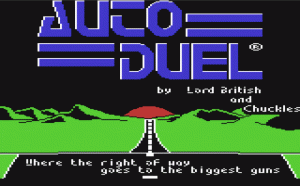 Video games are particularly susceptible to this. I still have all my old Apple II games – we’re talking about the authentic floppy disks, people – and they’re just as engrossing now as they were thirty years ago. If you haven’t played Autoduel, you just haven’t lived. And yet the reality is that all of us are guilty of spending vast sums of money on video games which we play, beat, perhaps revisit, and then lug around with us until the end of time, utterly forgotten.
Video games are particularly susceptible to this. I still have all my old Apple II games – we’re talking about the authentic floppy disks, people – and they’re just as engrossing now as they were thirty years ago. If you haven’t played Autoduel, you just haven’t lived. And yet the reality is that all of us are guilty of spending vast sums of money on video games which we play, beat, perhaps revisit, and then lug around with us until the end of time, utterly forgotten.
Games just don’t have that much of a relevant shelf life, do they? Let’s take a real megahit blockbuster, like Grand Theft Auto III. We’re talking about a once-in-a-decade game that just turns everything on its ear. And yet how long was it actually at the forefront of our consciousness as gamers? Perhaps twelve months? Maybe?
Look at what’s happening all around us right now. Skyrim. Skyward Sword. Arkham Asylum. Uncharted. Modern Warfare. These are huge, meat-slammer game titles that drive up the truancy rates in our educational system and burn sick days throughout the private sector.
Ten bucks says that we’re not talking about any of them a year from now. Maybe in some “Best of 2011” discussion, but that’s about it.
In the process, we’ve trained the modern gamer to be a voracious machine: grab a title on launch day, be the first to beat it, be the first to really BEAT it, and don’t take too long because you’ve got to be ready for the next megahit right around the corner. I believe it was Jack Paar – and I may be citing the wrong person – who said that if Americans had the choice of reading and absorbing all of Shakespeare’s work or taking a pill and instantaneously knowing all of it, they would almost unilaterally choose the pill.
If you’re starting to see why the mindset of the average gamer is somewhat at odds with the nature of PlayStation Home, then this preface has been worth the five-hundred words it took to put together. Home, which exists on a game console, is simply anathema to the typical gamer mentality. A game is a self-contained experience which holds your hand through a defined beginning, middle and end; Home, on the other hand, has no such handholding and no endpoint. It has the interface of a game, but it’s not a game.
This is why Home was first misunderstood and then written off by the gaming press at large, why it’s the subject of derision throughout much of the gaming community at large, and why Sony spent a fortune on the Hub but kept all of the gaming elements completely free to enjoy. This is why the Hub has an activity board with quests to complete, and why the PR statements about the Hub talk about Home becoming a game unto itself. Because after three years of open beta, the percentage of PSN users who “got it” – who understood what Home is, gravitated to it, and consistently spend money on the service – is just too damn low.
If you’ve read my previous articles on the business of Home, then you know the numbers I’m working with to base my hypotheses upon:
Total number of PSN users: 77,000,000
Number of PSN users who tried Home at some point: 15,400,000
Number of PSN users who periodically use Home: 3,080,000
Number of PSN users who regularly use Home: 616,000
Number of regular Home users who periodically spend money: 123,200
Number of regular Home users who regularly spend money: 24,640
Number of microtransactions for a “hot” item in Home: 20,000
Number of microtransactions for a typical item in Home: 5,000
As a disclaimer – I have no idea if my numbers are accurate or not. But having worked in resort development for nearly a decade, this sort of analysis isn’t anything new to me. So I’m making educated guesses as best I can.
The business logic of making Home more of a platform for gaming experiences is thus inescapable. Too many people, over the last three years, clicked on Home, didn’t get it, and clicked off. And in the gaming industry, that’s the kiss of death. Gamers are constantly looking for the next big thing to be handed to them, with minimal work on their part. A “social network for gamers” requires its audience to want to socialize, which demands three things:
- An effective means of communication, such as a keyboard;
- A desire to socially interact;
- A sufficiently interesting personality (and set of developed social skills) to be worth conversing with.
Jack Buser put it nicely when he said the following: “We discovered that if you put a lot of gamers in a room together and tell them to get to know each other, they don’t necessarily do that. But if you put them together and give them a game, they play and get to know each other.”
Translation: a lot of Home’s population is young, dumb and boring. Which, of course, is true. You need only spend five minutes in any heavily-trafficked public space in Home to see that. And games are a wonderful glue to bring disparate people together and foster friendships.
Let’s put it in perspective for a moment. HSM is one of the most literate media sources devoted to Home. It averages between 5,000 to 6,000 unique visitors per month. Most of this audience also frequents the other Home media sites out there, as well as the Sony forum itself. This is, however, only a tiny fraction of the total Home population. For every interesting
conversation that this group collectively starts, there are twenty failed “Hey bby ur hawt” facepalm moments in Home.
Not the best foundation for a social network for gamers. At all. But if that’s your target market, then you have to figure out how to make money off of them.
At first I figured turning Home into a subscription service would be the right move. But it isn’t. Although it would blessedly remove most of the bored kids from Home who don’t spend a dime and run around trolling, it would also cut out too much incidental revenue generation from users who aren’t regular spenders. It would also make it much more difficult for Sony to get third-party developers to sign on with Home, given the dramatically reduced audience exposure.
Home has numerous barriers to being a true social network for gamers, both technologically and sociologically. The PS3 isn’t bundled with a keyboard, and since Home is free to access, there are a lot of rude, crude, annoying and boring people running around in it. So the counterbalance is to put a much greater emphasis on games.
Going exclusively with a gaming emphasis isn’t necessarily the best solution, either – because games grow old, and games grow stale. Gamers, by their very nature, voraciously consume a hot experience and then leave it behind, rarely to return. This means that, in Home, a lot of games end up going by the wayside.
Don’t believe me? Stop by Dragon’s Green some time. Or Conspiracy. I could go on at length, but I have no wish to malign the developers who put together some very good gaming experiences which are now largely forgotten. In conducting research for this article, I stopped by a lot of the various gaming spaces in Home. And, with only a few exceptions, they’re
practically empty. You and I both remember when they were packed. Very few gaming experiences in Home have any sort of real staying power.
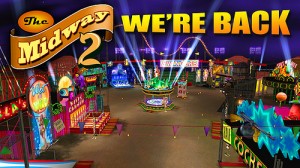 An interesting exception to this is Midway. Why is the Green Ticket the bestselling virtual commodity of 2011? I suspect it’s probably because the games are so basic, and so universally appealing, that they have high replay value. Mass Media isn’t necessarily the critical darling of Home – their marketing techniques are rather crass – but they’re pulling off a very difficult trick in Home: monetizing their commodities over a lengthy period of time after deployment.
An interesting exception to this is Midway. Why is the Green Ticket the bestselling virtual commodity of 2011? I suspect it’s probably because the games are so basic, and so universally appealing, that they have high replay value. Mass Media isn’t necessarily the critical darling of Home – their marketing techniques are rather crass – but they’re pulling off a very difficult trick in Home: monetizing their commodities over a lengthy period of time after deployment.
(I’m going to take this moment to chastise the community for not uttering a single damn word thanking Sony for not only bringing poker back to Home, but making such a proven hot commodity absolutely free to enjoy. I’m all for constructive criticism, and from a PR standpoint I’m not saying that Sony handled the removal of the EA poker rooms particularly well, but the utter lack of any sort of positive feedback at poker returning was, to put it mildly, disappointing.)
One thought that’s been gnawing at me for the last couple of weeks: the Hub, which took years and a ridiculous sum of money to develop, represents the single most overt shift in Home’s business model since open beta began. But is it enough?
I know that sounds like heresy. And keep in mind that I like the Hub and the dramatic facelift it gave Home. But has it accomplished what it was supposed to?
It’s too early to tell in terms of numbers, of course. But there are some interesting signs. The biggest personal observation I can make is that the Hub has fallen short of completely eliminating the single biggest popular complaint about Home: “There’s nothing to do and I’m so bored.”
Granted, there are always going to be some people who say that. And it’s a fairly ridiculous statement, given all that Home presently has to offer. As we’ve written about at HSM more than once, perception and reality are often two different entities. But Home presently has an uphill battle in changing perception, which requires different tools than changing reality.
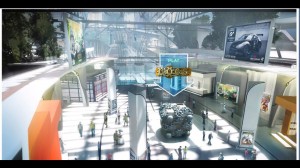 Like I said – I like the Hub, and I consider all of it to be a dramatic improvement for Home (even if I don’t particularly care for the aesthetics of the redesigned theatre). But here’s a personal observation: recently, I spent a few hours chatting with a couple of my friends out at the Hub’s dance floor. Now, granted, it was a weekend evening, which meant that more kids were running around. But it was a constant litany of trolls in default clothing running from person to person, committing all of the usual harassment acts we’re familiar with. And, over and over, the same comment kept popping up: “I’M SO BOOOOOOOOORED.”
Like I said – I like the Hub, and I consider all of it to be a dramatic improvement for Home (even if I don’t particularly care for the aesthetics of the redesigned theatre). But here’s a personal observation: recently, I spent a few hours chatting with a couple of my friends out at the Hub’s dance floor. Now, granted, it was a weekend evening, which meant that more kids were running around. But it was a constant litany of trolls in default clothing running from person to person, committing all of the usual harassment acts we’re familiar with. And, over and over, the same comment kept popping up: “I’M SO BOOOOOOOOORED.”
Wait a minute. Isn’t this specific objection what the Hub was designed to overcome? Wasn’t the whole point of the Hub to welcome a user into Home and provide a clear and immediate path to the gaming experiences?
Home is caught in-between two worlds right now. It’s reinventing itself to broaden its audience, and it’s trying to hold onto its core userbase who are waiting for social improvements that are hard to quantify in terms of ROIC. I don’t envy Sony’s position.
So now then. If the original concept of a social network for gamers wasn’t the answer, and an avalanche of gaming experiences isn’t the answer, then what are some viable business strategies to increase new user retention, revenue generation, and average user session time?
In short, what are some additional ways to keep Home from going stale?
1. Place a giant “GAMES” portal in a conspicuous spot in the Hub.
The Hub does a much better job than Central Plaza of pointing new users towards various attractions. That said, if games are going to be the focus, then make it the focus. I love Cogs and think it’s a great game, but it should be moved to another part of the space and a huge teleporter with a massive “GAMES” sign should be the centerpiece. Will it conflict with the existing “Games” store in the Hub? Doubtful. One’s a storefront and the other’s a teleporter. Keep in mind that the current teleporters in the Hub, located off to the sides, only take people to featured spaces at the moment.
2. Redesign the Navigator interface.
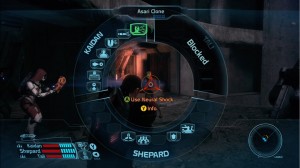 Yes, I know the interface has already been redone (anyone remember what it looked like last year?), and it’s not bad. But it’s simply functional, and does little to make Home feel like a game worth exploring – particularly since it’s the first interactive element anyone sees when they load up Home. An ideal interface would be akin to a BioWare skill wheel, with multiple spokes: GAMES, PUBLIC SPACES, PRIVATE ESTATES, CLUBS, and possibly some additional segments. Each would branch off into sphere grids akin to what we saw in Final Fantasy X.
Yes, I know the interface has already been redone (anyone remember what it looked like last year?), and it’s not bad. But it’s simply functional, and does little to make Home feel like a game worth exploring – particularly since it’s the first interactive element anyone sees when they load up Home. An ideal interface would be akin to a BioWare skill wheel, with multiple spokes: GAMES, PUBLIC SPACES, PRIVATE ESTATES, CLUBS, and possibly some additional segments. Each would branch off into sphere grids akin to what we saw in Final Fantasy X.
So, as an example, we choose the GAMES section of the Navigator skill wheel. It then takes us to a sphere grid showing all the public game spaces in Home, which you could highlight and get a description of before entering. This would also provide much greater visibility for older games in Home; with the present Navigator interface, unless you’re the currently featured game, you have to dig through a lot of sub-menus to find what games are available. They’re easy to overlook, which contributes to less traffic.
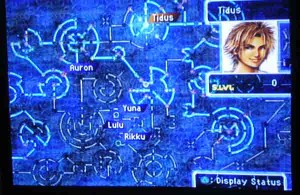 Another benefit to this sphere grid setup is that certain spaces could be seen but not entered unless predetermined criteria were met. For instance, a space restricted to a PlayStation Plus member would be visible on the sphere grid, but could not be entered until the user bought a subscription. This mirrors how video games work, in which you can see the skills you want to acquire but you have to go through the level grinding first.
Another benefit to this sphere grid setup is that certain spaces could be seen but not entered unless predetermined criteria were met. For instance, a space restricted to a PlayStation Plus member would be visible on the sphere grid, but could not be entered until the user bought a subscription. This mirrors how video games work, in which you can see the skills you want to acquire but you have to go through the level grinding first.
If Home is to be more of a game, then make its primary interface – the Navigator – something that reflects what you’d find in a game.
3. Develop a “world map” for Home.
This is more or less in line with the redesigned Navigator interface. The “Reimagine” poster that promoted the Hub showed what an interlinked Home conceptually looks like. Granted, most of the spaces aren’t directly interlinked, but having that sort of “world map” interface in the Navigator would make Home feel a lot more interlinked. Spaces could be grouped together by thematic neighborhoods, which is exactly in keeping with the district concept used by the Hub.
4. Create a “Home Plus” membership service.
Granted, I think Sony might already be in the process of doing this, but it’s long overdue. Home really does need a loyalty program, just as hoteliers and airlines have a loyalty program. If
there really are only about 25,000 consistent repeat-spenders in Home, then these are the people who should be targeted for additional revenue generation via a loyalty program. And such a program should hinge on one primary metric: money spent in Home.
Will this create a class divide in Home? Possibly. But it’s no different than how airline mileage loyalty members usually get to board a plane before the general public, or how hotel loyalty
members get room upgrades. In Home, there’s no question in my mind that extra games, public spaces, discounts and beyond should be made available exclusively to its most loyal consumers who consistently generate the most revenue. That’s just good business.
5. Develop an internal currency for Home which rewards gaming activities.
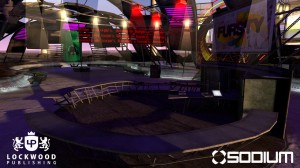 Lockwood has a great formula with the Sodium Hub: a captivating public space with mini-games, dancing, VIP section, and teleporters to their gaming areas. Most importantly, though, they have Sodium credits, which can be used in lieu of real money to acquire virtual commodities. This promotes longer average user sessions and generates revenue for their games, while giving the gamers who put in the effort a sense of exclusivity based on the difficulty of earning such rewards. Anyone who’s ever acquired a Golden VICKIE, for instance, can attest to this.
Lockwood has a great formula with the Sodium Hub: a captivating public space with mini-games, dancing, VIP section, and teleporters to their gaming areas. Most importantly, though, they have Sodium credits, which can be used in lieu of real money to acquire virtual commodities. This promotes longer average user sessions and generates revenue for their games, while giving the gamers who put in the effort a sense of exclusivity based on the difficulty of earning such rewards. Anyone who’s ever acquired a Golden VICKIE, for instance, can attest to this.
Thus, what if SCEA developed an internal currency for its spaces and games in Home? In essence, just a scaled-up version of what Lockwood’s already done. Another perk of a Home Plus membership, then, would be a stipend of some sort that Plus members could collect as a reward.
6. Increase clubhouse functionality and diversity.
This isn’t exactly a new request, and there have been some promising hints dropped about this, so I hope to see this soon. The criticism of the basic clubhouse in HSM and elsewhere is already well-documented, so there’s no need for me to rehash such an old topic, except to say that improvements to it are shamefully overdue. Clubs are a major component of the social experience in Home, and I leave it to more specialized articles to go into this topic in detail.
Home’s greatest weakness is that it all too often feels like a static experience. Subliminally, there’s a sense that you could go for months without visiting Home, and you wouldn’t really miss all that much. This is no different than playing around in a Grand Theft Auto city after you’ve beaten all the missions; once you know that the environment isn’t going to change, it
starts to feel…well, pointless.
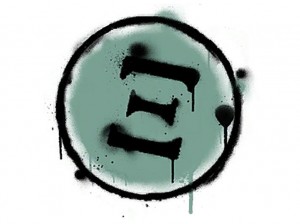 This is why Xi is so often cited as the high-water mark of Home: because it created a genuine sense of urgency. You had to keep returning to Home because the environment was changing, and you didn’t want to miss out. It turned Home itself into a game.
This is why Xi is so often cited as the high-water mark of Home: because it created a genuine sense of urgency. You had to keep returning to Home because the environment was changing, and you didn’t want to miss out. It turned Home itself into a game.
Now, granted, I doubt there’s any room in the budget to have ARG experiences in Home on a regular basis. But there doesn’t have to be. Sony has the right idea by turning Home into more of a game; the catch is that they’ve spent too much time on making it into a games platform (like Facebook) and not enough time examining how the infrastructure of Home itself can be manipulated to make it feel more like a game.
Is Home stale? No. At least, not to me. But that’s because I use Home as it was originally intended: a social network for gamers. Many of Home’s long-term users, if my observations are correct, have stuck around for the same reason. Unlike some, however, I don’t feel like Home has somehow let me down, or that Home owes me something. I just think that as Home ages, it becomes increasingly imperative to develop sustainable methods of making Home a dynamic, ever-changing experience. Dumping a ton of gaming experiences into Home and making it a games platform is a smart move, but games inevitably grow stale. The key is to make Home itself more of a game, so that people want to keep coming back.
When the Home userbase feels that subliminal urgency of, “I HAVE to get into Home regularly or I’m gonna miss out!” – that’s when Home will realize its potential to truly be a social network for gamers, and a compelling gaming experience unto itself. They’re on the right track, and I know that these sorts of developments take quite a bit of time to put together, so I’m quite hopeful for what the future holds.




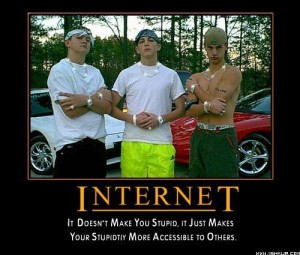
 LinkedIn
LinkedIn Twitter
Twitter
I agree with your assessment Norse. Gamers do move on once they have beaten a game, sometimes they even give up before the game is finished and move on, I am guilty of that myself, especially if I reach a point where it has become more of a chore than fun to get past a certain point.
The new navigator interface you suggested is brilliant! I think it would go a long way to helping new people to Home find the gaming experience they are looking for. I play some of the games in Home, not all, so it isn’t the reason I go in, but for those that do, it would be a vast improvement.
As for clubs, well lets not go there. They really need to get us past the basic club that has been in existence since the beginning of Home, enough said.
I think the numbers you used for spending customers is a bit low, I think there are many more than that who spend in Home based on my own observation of the people in public I see and my friends list alone. But that really isn’t the point, we still need to attract more spending customers if Home is going to have a real future, that is true.
I think people seem to forget that Sony is a business, out for profit, not a charitable institution. They get so caught up in the free stuff that Sony provides ( which has been a great deal lately I must say) that they don’t consider the fact that Sony needs to make money, or it will all go away.
Great article as usual Norse. Hopefully someone is listening.
I agree make home like an evolving organism ever changing never staying the same give gamers and home users something fresh and interesting everytime they login and they’ll be surely hooked lined and sinkered!!!
I believe more exclusive “to Home” games that are puzzle or strategy based, that can have an infinite amount of outcomes (like poker) would help. These type of games last the test of time and are favorites with many generations.
Sony also could benefit from spending a little time on redeveloping the avatars interaction with the Home environment and items. So much as been spent on Spaces Items and features, the avatar at its core has not been updated much since launch.
I would personally like to see the pop up menu with the different emotes be removed and replaced with a side bar that would change with a list of emotes, as your avatar moves about the Home world. For example if your avatar would approach other avatars,a menu of greetings and attitude emotes would pop up, if your avatar approached a items interactive emotes would pop up in the side bar..
I hereby claim an exemption from your chastisement as I did say some nice things(and bad) about poker and that I was glad it was back in Burbie52’s article about 1st impressions on the Hub.Anyways,this staleness was part of my original objection about turning Home into a gaming platform,even our most favored games get less usage over time whereas if your using Home as a social setting it never gets old.Now that it’s mostly about games Sony will have to continually update them or come out with new 1’s regularly in order to stay “fresh”.They are also competing with some top-notch disc-based games for my gaming attention and dollars and quite frankly are losing that match-up atm as Skyrim is getting most of it.I’m sure Skyrim will get old someday far in the future but if there is going to be extra downloadable content it will extend it’s freshness value,which is exactly what happened with COD Blk-ops for me.Blk-ops was still “fresh” almost a year after it’s launch because of the downloadable maps which were offered a few months apart from each other.This is the type of thing Sony will have to do for it’s profitable Home games in order to stay “fresh”.
I really like the idea of creating a “Home Plus” membership service. I don’t care about the games, but I would like access to a special HOME Plus member’s area. For example they could create a space that looked like a resort; which has nice rooms, a large pool area, a disco, etc. Yes, this might be seen as creating a class divide; but in a sense, class divides already exist. It would be nice if plus members had a space where they could hang out, and be less susceptible to the bored 14 year olds. By the way, as a father with 2 teen aged kids, I have found that some teens are committed to being bored. No matter how much you give them it’s never enough.
I’m still playing Borderlands.
I still play Jak and Daxter from time to time.
I still play Xenosaga regularly.
I still play Ultima Underworld on occasion.
I still play Monkey Island about once a year.
I just re-warched the Star Wars saga…
I’ve re-read Dune… I don’t know how many times.
Just because something doesn’t change doesn’t mean it’s stale. Things that are epic and classic never get old. If the content within Home was good enough… it would be enough. While this isn’t a blanket statement about ALL content within Home, I think it could cover a lot of it. How often did the IREM spaces get updated? How popular were those until their demise?
Many times, the fact that something is stale is more a commentary on those using the product than the product itself. People keep touting Home as a social gaming platform. Is it possible that the social aspect of this platform is the part that is truly lacking? Maybe it’s the community that needs an upgrade (with tools from Home)
I was also struck by the nothing that Xi was the “high-water mark of Home”… that was over 2.5 years ago… how sad that Home hasn’t A) replicated that experience since and B) that there hasn’t been better experiences since.
You’ve got my mind going Norse… Time to put pen to paper… so to speak.
Of course we still play older games we liked occasionally but the rush we experienced when playing them at 1st is long gone.The problem with the new Home is that it doesn’t provide the gaming rush that I can get elsewhere.However it still provides the social rush I 1st experienced when I 1st started playing it,mainly because there are few alternatives on the PS3 in it’s catagory.For me the high water mark for games on Home was the old EA poker room,sorry XI was before my time,and is a good example of how Sony fixes what wasn’t broken and rarely fixes what should be fixed.They brought back Poker but is it like the old days?That answer will depend on the person but for some it is not.It’s good but not much different than the poker table that many of us already bought.The staleness could be a commentary on those using the product or the product itself but stale is stale and not many ppl choose staleness when you can have top-self games straight out of the oven.Playstation users have acquired a certain taste for a certain level of quality when it comes to games thanks to disc-based games of the past.Basically Home is asking hardcore game addicts to play games that some would consider sub-par.This is very similiar to asking hardcore drug users to be happy with childrens aspirin.Sure they might take them(or not) but they certainly won’t love them.The bar for games on Platstation is pretty high and games that don’t have a “hook” of some kind or an already built-in audience will have problems getting new users to take a long look at them.The games you listed probably made some kind of impression on you which is why you continue to play them,but would you play Super Mario Bro.’s today if you had to choose between it and Skyrim(assuming they were on compatible systems)?Unless you hate the Oblivion series or really love Mario I’m guessing you wouldn’t choose Mario very often.
Hell yea I would, and DO, play Super Mario Bros! That’s why I bought Super Mario Bros All Stars for the Wii, so I could put my SNES away. Different games provide different expereinces. As for making an impression on me, they certainly did.
And this is what Home needs to do to keep from getting stale… make an impression on us.
I meant the original 8-bit game in my question not the current generation of Mario Bros.
Me too. It’s in there.
The 8-bit was NES not SNES which was 16-bits I believe.
You continue to mis-understand. Super Mario Brothers All stars was an SNS game that included Super Mario Bros 1,2 & 3 (all from 8bit Nintendo era). While All Stars DID have improved graphics, the games were completely untouched in terms of gameplay. Think of Beyond Good and Evil HD. Same game with improved visuals.
I see,well I abandoned Nintendo a long time ago right around the time the PS1 came out,so I’m really not up to date on my Mario games but it’s really irrelevent.I was really reffering to the graphic quality of the 8-bit era and not so much as Mario specifically.Actually Home’s games don’t even have the nostalgia yet that Mario has so it really was an inaccurate analogy.I should’ve asked would you rather play Skyrim or a way inferior,graphically speaking,game with your limited gaming time.Unless the game had some kind of a “hook” or was a game I liked already I’m probably going with Skyrim with my time and money.That’s what I was really getting at here.
I agree.heh.
To further explain what I was getting at: I’m assuming that most ppl have a limited amount of time each day that they can spend playing video games.If so then wouldn’t you devote that time to w/e game interests you the most?How much of that time would you be willing to spend trying games with uncertain to you entertainment value and sub-par graphics(in relation to disc-based PS3 games) when you have some disc-based games you are very interested in?I’ve heard it said that Home is trying to replicate the success that Facebook has with their games being that they are similiar graphically,Idk if they are as I don’t use Facebook,but here’s why I think Facebooks games do well.Facebook’s games have a built-in audience,ppl are already there doing social things and probably figure as long as they are already there anyways why not give them a chance.I think in that case it’s the social aspects driving the games,Home is now trying to get the same success by doing the exact opposite.That way can succeed financially too but the games will be judged much harsher,Facebook could probably make cash off of a Scribble knockoff,and will have shorter self-lives which means continually updating them or keep coming out with new 1’s,another words keep fresh and relevent or go stale and fade into obscurity.
I completely agree. I’ve made that comment before in previous articles. That the difference between Facebook gaming and Home gaming is Home continues to try to CREATE an audience for their content, where as Zynga went out and created content for an EXISTING audience.
Home is too isolated to find the same sorts of success as other social media games. Sony isn’t taking the concept of social synnergy to heart and until they do (by tying Home into the outside world) they will continue to falter.
oh, and LOVE skyrim. Just upgraded my lap top to what I have named “The Beast” and am considering trading in my xbox 360 version for the PC version.
Wait… no… I just decided. Im trading it in. hehehe.
Good points, Gideon. I actually didn’t pick up a PS3 until 2009 because, as far as I could ascertain, the current generation of game consoles at that time just didn’t have any really engrossing experiences that I could sink my teeth into the way I could with the previous console generation.
We had a story assignment a while ago about what elements make up a successful public space in Home, and I think that’s more relevant now than ever. If there are a lot of derelict spaces in Home, it’s because they’re just not particularly interesting, nor are they conducive to social gatherings. And, as cthulu pointed out, Home will never be able to match the graphical superiority or intensity of a pure gaming experience that’s had millions upon millions of dollars thrown at it.
There is no question in my mind that what Home is lacking — badly — are social enhancements. Granted, it’s not like I’m alone in this assessment; enhancements to the social aspects of Home have been some of the most frequently repeated community requests for years. Yes, they require core client updates and yes, they’re expensive without a clearly defined way to show an ROIC. But they’re absolutely necessary. If Home cannot match the gaming experiences a PS3 user is looking for, then it must offer a truly engrossing social experience to compensate.
Granted, a big chunk of Home’s society is young, dumb and boring. Hence why HSM’s greatest criticism of Home has nothing to do with the people who built it, but rather the people who populate it. That said, it doesn’t eliminate the sound business logic in improving Home’s social features.
I like the idea of Home becoming more of a game. That makes a lot of sense to me. The catch is that they’re still using a formula that inherently lends itself to stale results. If Home is to be more of a game, then *make* it a social game. Home’s engine has the interface and architecture of an MMO; it’s practically screaming for a large-scale MMO development. And it would make the Home experience itself something compelling to return to on a frequent basis, which hasn’t been seen since Xi.
*nods*
My biggest peeve with the way Home is run is with WHAT they are developing. IMO the time and effort put into Bootleggers (as cool as it is) was a waste. Why would I play a sub-par FPS on Home when I can just gamelaunch Killzone or Resistance?
You guessed 24,640 users spend money in Home regularly. Let’s assume that means $5 a month (I think I’m low-balling that figure) That’s $123,200 per month, or 1,478,400 annually. That is PLENTY of money to invest in more robust Home development. Do we have any idea how many people are even ON the Home team? Is it just an undergrad and a chimp that’s available to code new features for Home?
My best guess — and I freely admit it’s merely a guess, with a very wide margin of error — is that Home averages somewhere in the neighborhood of three- to four-million dollars per year in microtransactions. I’m sure they have other revenue streams behind the curtain as well, but these are all gross numbers. Without knowing Home’s operating costs and overhead, we don’t know how truly profitable Home might be.
On one hand, I get the logic behind developing Home versions of popular games. Having an FPS (Bootleggers) or a really slick multiplayer racing game (Sodium2) in Home is a great way to help publicize the power of the platform, and in an era where games are sixty bucks a pop (and climbing), Home’s freemium model provides a fairly decent substitute.
That said, Home right now is playing to its weaknesses instead of its strengths. I totally understand the need to turn Home into more of a gaming experience, because its original vision of a social network for gamers requires sufficient numbers of people who have the technology and social skills to make it viable.
Home, right now, is unique: it’s the only console-based virtual reality application out there. And it would be highly advisable to incur the expense of a core client update which dramatically enhanced the social aspects of Home, for exactly the reason you cited, Gideon.
What I’m *hoping* will happen is that someone will turn Home into a true MMO. It has the engine and architecture of an MMO, and it would make Home a “must see” experience, instead of a static platform for various gaming experiences. If we’re very lucky, Home may have something like this already in development (consider how long they were working on the Hub before anyone ever knew about it), but I’m very curious to see what the new year brings.